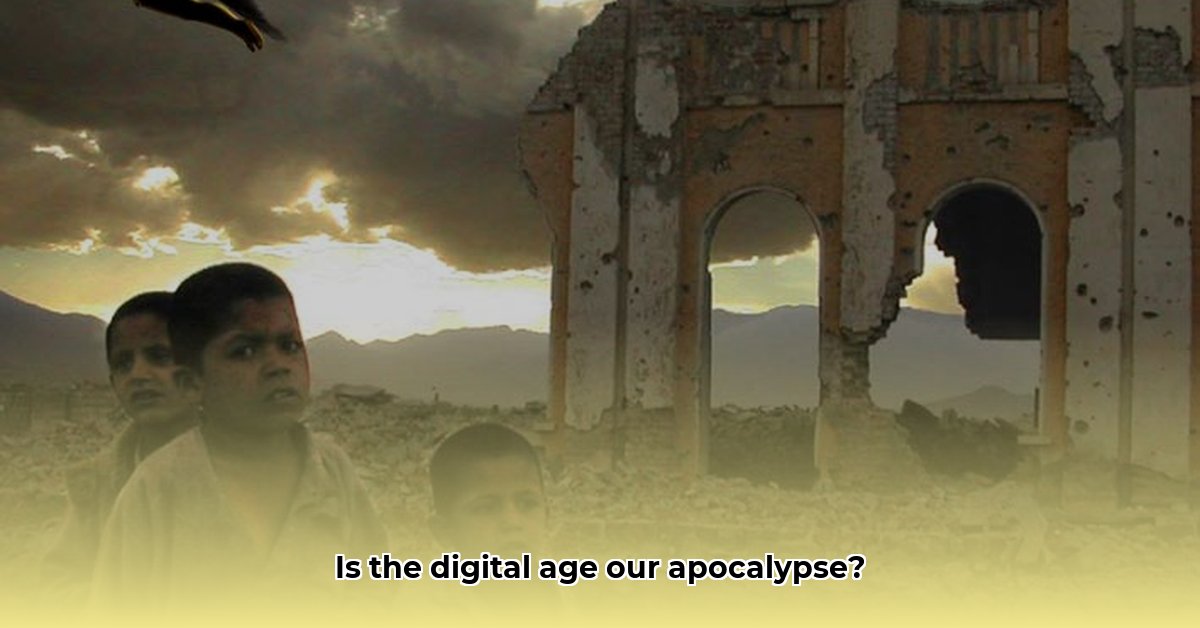The Allure of the End: Understanding Our Fascination with Doomsday
The premonition of the world’s end is a recurring theme throughout history, but the 24/7 news cycle and the pervasive nature of social media amplify such anxieties today. This article explores the complex interplay of apocalyptic beliefs, political motivations, and social theories, focusing on how these factors shape our understanding of the present and anxieties about the future. Using QAnon as a primary case study, we’ll examine how these beliefs intersect with contemporary politics and conspiracy theories, particularly within the digital landscape. We will delve into the history of apocalyptic thinking, analyze its psychological and sociological underpinnings, and consider its potential societal consequences.
Deconstructing Doomsday: A Historical and Theoretical Perspective
Why are end-of-the-world narratives so compelling? They tap into primal human emotions: fear of the unknown, hope for a better world, and the desire for justice. These anxieties have long been intertwined with religious beliefs and political motivations. From the Crusades to various doomsday cults, history provides ample evidence of the potent mix of faith and fear.
Social theory offers valuable insights into this phenomenon. Richard Hofstadter’s concept of the “paranoid style” in American politics suggests that conspiracy theories and anxieties about societal decay frequently become intertwined with end-times narratives. These narratives offer a sense of order amidst chaos, identifying clear enemies and promising ultimate vindication for believers. They provide simplified explanations for complex problems, a comforting dichotomy in an often ambiguous world.
QAnon: A Digital-Age Apocalypse
QAnon provides a chilling contemporary example of apocalyptic thinking converging with religious fervor, political anxieties, and social theories in the digital age. It weaves together cryptic online messages, political grievances, and prophecies of impending doom followed by a “Great Awakening.” Social media platforms, with their echo chambers and rapid information dissemination, amplify these beliefs, enabling their swift and widespread propagation.
Expert insights from researchers such as Donovan, Zadrozny, Jones, and McCurry, shared during discussions at Columbia University, illuminate these dynamics. They highlight how QAnon strategically leverages existing religious frameworks and political frustrations, transforming them into a compelling narrative of imminent salvation and judgment. This narrative resonates with certain anxieties within society and offers a sense of belonging in an increasingly fragmented world.
Millenarianism: Echoes from the Past, Resonances in the Present
Apocalyptic and millenarian movements, characterized by a belief in a transformative event—whether utopian or catastrophic—are not new. They have profoundly shaped societies and political landscapes for centuries. Groups like the 19th-century Millerites, who anticipated the Second Coming of Christ, and the 20th-century Branch Davidians, who believed in an apocalyptic showdown, demonstrate the diverse manifestations of these beliefs.
| Feature | Millerites | Branch Davidians |
|---|---|---|
| Leader | William Miller | David Koresh |
| Time Period | Mid-1800s | Late 1900s |
| Core Belief | Imminent Second Coming of Christ | Spiritual siege, apocalyptic battle |
| Outcome | “Great Disappointment,” fractured movement | Waco siege, tragic loss of life |
Comparing these groups reveals the profound impact of millenarian beliefs, even when their specific expressions and outcomes differ drastically.
The Digital Echo Chamber: Amplifying Anxieties
Echo chambers, online communities where information is repeatedly reinforced regardless of its accuracy, play a significant role in the spread of apocalyptic ideas. These digital spaces validate existing biases and exclude dissenting views, potentially increasing polarization and radicalization. Individuals become isolated within their information bubbles, surrounded by those who share their beliefs, hindering exposure to alternative perspectives.
The Algorithm’s Influence: Manipulating the Message
Social media algorithms, designed for user engagement, prioritize content that evokes strong reactions, including sensational and conspiratorial material. This dynamic inadvertently creates fertile ground for misinformation, exacerbating political divisions and blurring the lines between fact and fiction. This constant exposure to alarming information can heighten anxiety and make individuals more susceptible to apocalyptic narratives offering simplistic explanations for complex problems.
Navigating the Digital Apocalypse: Critical Thinking in a World of Misinformation
Understanding the intricate relationship between apocalyptic thinking, religious beliefs, political dynamics, and social theories is paramount, especially in our digital age. We must critically examine how these forces interact and influence each other. Key questions emerge, such as:
- What are the ethical implications of allowing apocalyptic narratives to proliferate online?
- How can we promote media literacy and critical thinking to combat the spread of misinformation?
These questions demand our attention, as the stakes are high, impacting not just individual beliefs but also the broader social and political landscape. Open dialogue, ongoing research, and a nuanced understanding of these issues are crucial for navigating the challenges of an increasingly complex information environment.
What Fuels Apocalyptic Thinking? Unpacking the Impulse
The “apocalyptic impulse,” a powerful draw towards beliefs about impending doom and societal upheaval, is a complex phenomenon with roots in religion, politics, and the digital world. Religious interpretations of end-times prophecies can create a sense of anticipation and meaning, particularly for those seeking purpose in uncertain times.
Political rhetoric, often demonizing opponents as existential threats, can also exploit apocalyptic narratives. This “us vs. them” mentality intensifies existing divisions, creating a breeding ground for extreme views.
Social media significantly amplifies these trends. Algorithms create echo chambers, reinforcing existing beliefs and limiting exposure to alternative perspectives. Misinformation flourishes in this environment, with dubious stories rapidly shaping opinions and amplifying fears.
Conspiracy theories, like QAnon, provide simplistic answers and scapegoats for complex problems, further fueling apocalyptic anxieties. The allure of secret knowledge and belonging to an “in-group” can be incredibly potent. Exploring historical precedents, such as the rise of the Christian right and the Satanic Panic, provides further context for understanding how these narratives take hold and spread.
The fascination with apocalyptic scenarios likely stems from a combination of factors: the search for meaning, fear of the unknown, and the desire for belonging. As experts continue to study this complex phenomenon, our understanding will likely evolve.
The Importance of Understanding Apocalyptic Thinking in the Digital Age
In today’s information-saturated world, distinguishing fact from fiction can be challenging. The rise of apocalyptic thinking online, fueled by echo chambers and algorithms that prioritize engagement over accuracy, poses a significant threat to informed decision-making. This phenomenon can intensify anxieties, erode trust in reliable sources, and contribute to a pervasive sense of doom.
Religion and politics have both found powerful tools in the digital landscape. Online religious communities dedicated to apocalyptic interpretations can foster a sense of belonging but also potentially lead to more extreme views. Similarly, political movements can exploit apocalyptic rhetoric to mobilize support, spread misinformation, and justify extreme actions.
Social theories, such as the secularization thesis, postmodernism, and risk society theory, offer valuable frameworks for analyzing the complex interplay of forces driving the rise of digital doomsdayism. QAnon, with its blend of conspiracy theories, apocalyptic beliefs, and political extremism, serves as a stark illustration of these dynamics.
Navigating this digital landscape requires critical thinking, media literacy, and a healthy dose of skepticism. We must question the information we encounter, consider the source, and seek multiple perspectives. It’s about recognizing the difference between genuine threats and the “digital phantoms” of our collective anxieties.
Social Media’s Role in Amplifying Apocalyptic Narratives
Social media algorithms, designed to maximize user engagement, often prioritize sensational content like doomsday predictions and conspiracy theories. This creates a “snowball effect,” where these narratives gain momentum, spreading rapidly within echo chambers that reinforce existing beliefs and limit exposure to diverse perspectives.
The speed and reach of social media enable rumors and misinformation to spread globally almost instantaneously, making it difficult to distinguish fact from fiction. This can erode trust in reliable sources and create a sense of anxiety, making individuals more susceptible to apocalyptic narratives.
Online spaces dedicated to these narratives can become breeding grounds for extremism. While social media isn’t the source of these beliefs, it acts as an accelerant, enabling ideas to spread and evolve at an unprecedented rate. Real-world events, like climate change and political instability, can provide further fuel for these anxieties, offering a backdrop for conspiracy theories and apocalyptic interpretations.
QAnon serves as a prime example of how these narratives can blend with political distrust and secret plots, gaining massive traction online. Understanding the complex reasons behind the appeal of these narratives, such as feelings of helplessness and a yearning for simple explanations, is crucial for addressing this issue. Promoting media literacy, critical thinking, and holding social media platforms accountable are essential steps in fostering a more resilient online community.
QAnon: A Case Study in Contemporary Apocalyptic Politics
QAnon, a contemporary example of the “paranoid style” in American politics, epitomizes the convergence of millennialism, apocalypticism, and conspiracy theories. It exploits anxieties about societal change by offering a simplified narrative of good versus evil, with Donald Trump positioned as a savior figure battling a “deep state.”
QAnon’s apocalyptic prophecies, including “The Storm” and “The Great Awakening,” promise a cathartic reckoning and a virtuous new world order. This narrative gives followers a sense of purpose and belonging but exhibits flexibility, adapting and incorporating new conspiracy theories to justify unfulfilled predictions.
Social media’s role as both echo chamber and amplifier is crucial to QAnon’s spread. Algorithms inadvertently prioritize sensational content, boosting the visibility of misinformation. The January 6th Capitol riot demonstrates the real-world consequences of these beliefs, highlighting how apocalyptic urgency and dehumanization of perceived adversaries can lead to violence. Combating QAnon requires critical thinking, media literacy, and fostering a culture of respectful dialogue.
While QAnon’s core tenets remain consistent, the movement’s adaptability allows it to absorb and reinterpret other conspiracy theories, maintaining its relevance. Ongoing research seeks to understand this fluidity and the psychological and sociological factors contributing to its appeal. Exploring different perspectives and remaining open to new information is crucial for addressing this complex phenomenon.
| Aspect of QAnon | Description | Potential Implications |
|---|---|---|
| Apocalyptic Framework | Presents current events as a cosmic battle between good and evil, promising a future reckoning and a new world order. | Fuels extremism and justifies violence against perceived enemies. |
| Paranoid Style | Characterized by conspiratorial thinking, suspicion, exaggerated narratives, targeting a “deep state” and perceived threats. | Creates distrust in institutions,fuels political polarization. |
| Role of Social Media | Utilizes social media platforms as echo chambers and amplifiers, exploiting algorithms that prioritize sensational content. | Contributes to rapid spread of misinformation and filter bubbles. |
| Real-World Consequences | Influences political discourse and actions, potentially inciting violence and disrupting social stability, as seen in the January 6th Capitol riot. | Threatens democratic processes and societal well-being. |
| Adaptability | Continuously evolves, integrating new conspiracy theories and adapting to changing circumstances, making it difficult to counter. | Ensures the movement’s longevity and relevance despite debunking efforts. |
| Ongoing Research | Studies explore the psychological and sociological factors contributing to QAnon’s appeal, along with its long-term impact on political discourse and social cohesion. | Further understanding is needed to develop effective counter-strategies. |
Our understanding of QAnon continues to evolve. New research may challenge existing assumptions, emphasizing the importance of remaining open to new information and diverse perspectives when examining this phenomenon.
- Wind Turbine Generator Kit For Home: Is One Right For You? - November 2, 2025
- Wind Turbine Fire: Questions About Safety Spark Debate - October 31, 2025
- Vertical Axis Wind Turbine Design: Improving Efficiency and Overcoming Limits - October 29, 2025
















